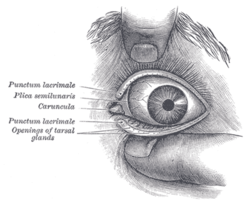
Palpebral fissure

The palpebral fissure is the elliptic space between the medial and lateral canthi of the two open lids. In simple terms, it refers to the opening between the eye lids. In adults, this measures about 10mm vertically and 30mm horizontally. The palpebral fissure is the elliptic space between the medial and lateral canthi of the two open lids. In simple terms, it refers to the opening between the eye lids. In adults, this measures about 10mm vertically and 30mm horizontally. It can be reduced (short, 'narrow') in horizontal size by fetal alcohol syndrome and in Williams syndrome. The chromosomal conditions trisomy 9 and trisomy 21 (Down syndrome) can cause the palpebral fissures to be upslanted, while Marfan syndrome can cause a downslant. An increase in vertical height can be seen in genetic disorders like cri-du-chat. The fissure may be increased in vertical height in Graves' disease, which is manifested as Dalrymple's sign. Seen in disorders like cri-du-chat. Narrowing of the fissure can be a prominent indicator of myofascial trigger points in the ipsilateral sternocleidomastoid muscle's sternal division, a common cause of tension headaches, particularly those felt around the eyes and sinuses. In animal studies, using four times the therapeutic concentration of the ophthalmic solution Latanoprost, the size of the palpebral fissure can be increased. The condition is reversible. Latanoprost is a prostaglandin F receptor agonist.
